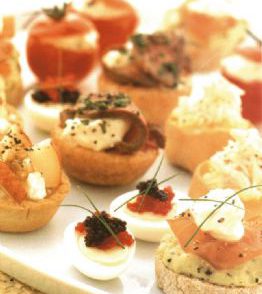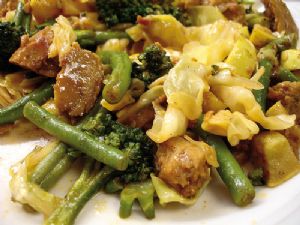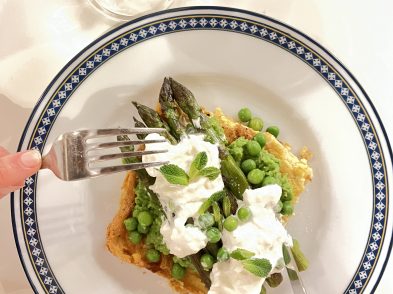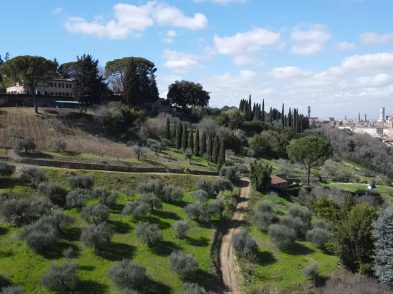Please forgive the dreadful pun and console yourselves
with the knowledge that it could have been worse if I’d have chosen a different
seafood to write about this issue. (‘Prawn stars’, ‘Whelk hello’, or ‘A clam
for all seasons’, for example. Lucky escape, huh?) As it is, this article is
again devoted to one of the best small things to come out of the ocean, and one
which lends itself very well to dinner ideas at this time of the year: the
mussel.
Finding out that these tasty little beasts are popular
across Italy
was a comforting moment: finding out that they’re available from supermarkets,
at a good price and of high quality, was even better. And, for simple bivalves
that need to be steamed open, they are surprisingly versatile and can be cooked
in a number of ways and complemented with a variety of different flavours,
depending on your tastes. Good news all round, unless you’re allergic to
shellfish.
Shop-bought mussels will come in
little nets, with the barnacles chipped off them and the ‘beards’ (tough, fibrous
matter along the edge of the tear-shaped shell) scrubbed off. They need to be
cooked when they’re still alive, and to determine whether or not they’re
suitable, each shell should be checked. If it’s tightly closed, it’s fine. If
it’s open, give it a tap: a shell that closes up of its own accord is edible,
but one that stays open or needs to be forced shut should be thrown away. Sometimes,
mussels are quite sandy: you can place them in a large bowl of cold water with
half a teacup full of flour for half an hour, and they will disgorge most of
the grit and inedible crunchy things that they contain. Once you’ve done this,
give them a good rinse and they’re ready to cook.
Frequently, in the first
instance, mussels are cooked in liquid with vegetables, which encourages the
shellfish to exude a liquor as they cook. Once the mussels have all been eaten,
this delicious broth can be mopped up with bread or cooked rice. Traditional zuppa
di cozze ingredients include onion, celery, garlic, parsley and stock,
maybe with or without tomatoes. Alternatively, you can take flavours from the burrida,
such as chopped tomatoes, anchovies and mushrooms. Shallots, leeks, saffron and
cream go very well with mussels, as does white wine, as a liquid to cook them
in: since the shellfish don’t take a long time to cook, the wine infuses the
vegetables, shellfish and broth with a rich, alcoholic taste (the dish is ready
before it’s all cooked away).
Once the mussels have been cooked, and the shells have
opened, yielding the soft, pale interiors-see the recipe for mussels in white
wine-they can be further tinkered with for the sake of some really great flavours.
If you remove the bivalves from their shells, dredge them in flour, egg and
breadcrumbs and fry them, they can be served as snacks: sprinkle them with
lemon juice and seasoning and serve while still hot. They can be served on
slices of fried bread, with a good spoonful of their own juices drizzled over
the top and a grind of black pepper. If you’re serving mussels like this, it’s
sometimes best to cook them in their own liquid only, by putting them in a pan
alone, covering it tightly, and letting them steam themselves open for a few
minutes over a hot flame. This preserves the rich ocean flavour of the
shellfish.
Mussels can be used on top of pizzas-with a simple
tomato and parsley accompaniment, perhaps-and in salads with chopped egg,
potatoes, vinaigrette dressing, and parsley (again). Or you can try opening the
shells right up and removing one half, arranging the mussels in the remaining
half-shells, and covering with garlic butter: these can then be baked, roasted
or grilled until the butter starts to sizzle.
Grilled mussels, cooked like this, should be arranged
on plates and served with something good to dip them into.
Once you’ve made up your mind how you want to cook the
mussels, you’re at liberty to make a few more decisions of your own: What are
you going to serve them with? Do you want to cook them on a flame outdoors? Is
bread enough to mop up the juices, or would you like to try it the Belgian way
and serve them with French fries? One thing is certain, though: a dish of
mussels leaves you satisfied enough to savour the flavour for long after the
dishes have been washed, but is also light enough to leave you wanting many,
many more.
RECIPES
Ingredient of the fortnight: WET GARLIC
At this time of the year, garlic that was planted late
last autumn is at the stage where it looks as if it’s almost ready to dry and
use. The bulbs are small, and the leaves are strong, rich green and broad. The
whole thing looks a lot like a cross between a spring onion and a tiny leek.
The only thing which really gives it away is the distinctive smell, which at
this stage is still at the ‘lovely kitchen aroma’ stage, rather than the
‘stranger standing way too close to you on the bus’ level.
However, garlic at this stage of its development is
also great to cook and eat. When it’s very new, fresh or ‘wet’ garlic can be
eaten raw, with a good sprinkle of sea salt, in fine slivers, in a salad: the
taste is there, but tempered by sweetness. The white bulb, when you chop it,
will fall into tiny slivers, since the cloves haven’t properly formed yet.
The bulb can also be added to sauces, whereas the
leaves make a fine addition to slow-cooking soups, stews and sauces, adding a
lot of flavour and texture. As soon as the bulbs start to go a little more
fibrous, crinkled and swollen on the outside, they should be cooked instead of
eaten raw, since the flavour is starting to develop a bit too much. Try frying
it lightly in oil or butter, then adding some chopped cabbage or greens to the
pan, covering it and allowing the vegetables to steam among the sauteed garlic.
Recipe of the fortnight: MUSSELS IN WHITE WINE
500g mussels, cleaned as described elsewhere on
this page
250ml white wine
80ml water
25g butter
2 sticks of celery, chopped
3 or 4 small onions or shallots, peeled and diced
very finely
1 small bunch parsley, washed and chopped very
finely
1.
Melt the butter in a deep pan with a lid, over a low
heat, until foaming lightly. Add the celery and shallots and allow them to cook
lightly for a few minutes, until starting to soften.
2.
Add the mussels, the wine, and the water, and increase
the heat to bring it to a simmer. Cover tightly and cook for 10 to12 minutes,
or until the shells have fully opened.
3. Season,
stir in the parsley, and serve.







